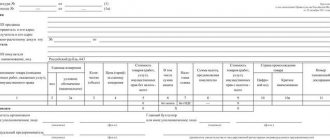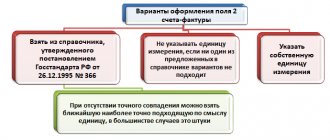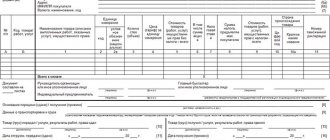The cost of goods has decreased: what documents are needed from the supplier?
The seller (supplier) can reduce the cost of goods after they have been shipped to the buyer.
When this can happen, says the material “What is an adjustment invoice and when is it needed?” .
At the time of making such a decision, the parties to the transaction already have the following set of documents in their hands:
- contract with initial delivery conditions;
- original invoice (PSF);
- primary document for the shipped goods;
- other documents (certificates, technical specifications, etc.).
From 07/01/2021, a new invoice form is in effect, as amended by Decree of the Government of the Russian Federation dated 04/02/2021 No. 534. The update of the form is due to the implementation of a goods traceability system. All taxpayers are required to use the new form, even if the goods are not included in the traceability system. Read more about the changes made to the document here.
You can download the new invoice form by clicking on the image below:
ConsultantPlus experts have prepared step-by-step instructions for preparing each line of the updated invoice. To do everything correctly, get trial access to the system and go to the Ready solution. It's free.
A decrease in the cost of goods is accompanied by additional documents:
- agreement or other type of consent of the buyer to change the initial terms of the transaction (clause 10 of article 172 of the Tax Code of the Russian Federation);
- adjustment invoice (CSF) for reduction;
- a new primary document on changes in the value of goods containing the necessary details (Article 9 of the Law “On Accounting” dated December 6, 2011 No. 402) - it will serve as the basis for reflecting adjustment transactions in accounting (letter of the Federal Tax Service of Russia dated January 24, 2014 No. ED-4 -15/ [email protected] ).
The absence of these documents may deprive counterparties of the right to deduct VAT under the CSF and leave adjustment accounts unconfirmed.
IMPORTANT! The adjustment invoice form has also been updated as of 07/01/2021 (see Decree of the Government of the Russian Federation dated 04/02/2021 No. 534).
You can download the updated adjustment invoice form by clicking on the image below:
You can view and download a sample adjustment invoice for reducing the price of goods in ConsultantPlus. Get trial access to the system for free and proceed to the filling example.
From the next section, find out what actions are required in the accounting of the buyer and seller when the CSF appears.
Buyer situations
When a reduction adjustment invoice is received from a vendor or supplier, the postings depend on the specific reason for issuing the document. The table below discusses the main situations on this issue.
| Postings when decreasing | |
| Situation | Solution |
| Received a discount on items already purchased. According to the terms of the contract, she adjusts their price | 1. Discount on goods that the buyer has not yet sold: · REVERSE Dt 41 – Kt 60 (goods were purchased for the amount indicated in column 5 of line “Total reduction (sum of lines D)” of the adjustment invoice; · Dt 60 – Kt 68 (VAT has been restored for the amount from column 8 of line “Total reduction (amount of lines D)”. 2. Discount on goods that the buyer has already sold: · REVERSE Dt 90-2 – Kt 60 (writing off the cost of sales for the amount from column 5 of line “ Total reduction (sum of lines G)"; · Dt 60 – Kt 68 (VAT has been restored for the amount from column 8 of line “Total decrease (sum of lines G)". |
| The buyer accepted a smaller number of goods than agreed upon in the initial invoice from the seller (for example, due to defects or incomplete delivery) | There is no need to change anything in accounting, since valuables need to be capitalized only upon their acceptance (letter of the Ministry of Finance dated February 10, 2012 No. 03-07-09/05). That is, no additional wiring is needed. |
Where are reduction adjustment invoices recorded?
The CSF for reduction is subject to registration by both the seller and the buyer.
Seller's actions
By reducing the cost of shipped goods, the seller:
- draws up a CSF or consolidated CSF;
- transfers data from the KSF (consolidated KSF) to the purchase book (clause 13 of Article 171 of the Tax Code of the Russian Federation);
- takes for deduction the difference between the VAT amount on the PSF and the reduced tax amount calculated after making adjustments.
The seller has the following rules regarding CSF for reduction:
- VAT clarification for the period when the shipment occurred does not need to be submitted;
- It is possible to claim a deduction within 3 years from the date the CSF is set for reduction (clause 10 of Article 172 of the Tax Code of the Russian Federation).
Buyer actions
The buyer upon receipt from the seller of CSF for reduction:
- registers it in the sales book;
- restores the portion of VAT previously accepted for deduction.
He will not have to submit an updated declaration and pay penalties.
Find out how to take into account and use what details to transfer VAT penalties from the article “Under which BCC are VAT penalties paid?”
Features of accounting in one period and in different ones
If the cost of shipped products (services, property rights) increases in the current period (adjustment period):
- in the current period, the seller includes the resulting difference in the tax base, regardless of the period in which the products (services, property rights) were shipped (clause 10 of Article 154 of the Tax Code of the Russian Federation);
- the buyer makes a tax deduction for the difference between the VAT calculated before and after the adjustment (clause 13 of Article 171 of the Tax Code of the Russian Federation).
Kontur.VAT+ takes into account adjustments and corrections and verifies the results with counterparties for all quarters.
Find out more
If the cost of shipped products (services, property rights) decreases in the current period (adjustment period):
- the seller makes a tax deduction for the difference between the VAT calculated before and after the adjustment (clause 13 of Article 171 of the Tax Code of the Russian Federation). At the same time, the tax base, which was determined at the time of shipment of products (services, property rights), is not adjusted;
- the buyer recovers VAT for the amount of the difference between the VAT calculated before and after the adjustment (clause 4, clause 3, article 170 of the Tax Code of the Russian Federation);
- adjustments for reduction are carried out with KVO 18.
The seller and buyer reflect these transactions in their purchase and sales books as follows:
To correctly record adjustments in the books of purchases and sales in different reporting periods, use the following cheat sheet:
Example 1
According to the lease agreement between Sokol (lessor) and Lastochka (tenant), the rent amount is 106,000 rubles.
per month (including VAT). According to the additional agreement concluded in February 2022, the rental payment increased to RUB 112,600. per month (including VAT). According to the additional agreement, this change is effective from October 1, 2022. For the 4th quarter of 2022, rent amounted to RUB 318,000. (including VAT - 48,508 rubles). After concluding an additional agreement in February 2022, rent for the 4th quarter of 2022 increased to RUB 337,800. (including VAT - RUB 51,529).
In February 2022, after signing the additional agreement, Sokol issues an adjustment invoice to Lastochka and indicates:
- the previous amount of the lease payment for the 4th quarter of 2022 (RUB 318,000, including VAT - RUB 48,508);
- new rental payment amount for the 4th quarter of 2022 (RUB 337,800, including VAT - RUB 51,529);
- difference (increase) (RUB 19,800, including VAT - RUB 3,020).
In this situation, Sokol increases the tax base for the 1st quarter of 2019 by registering an adjustment invoice in the sales book for this period by 16,780 rubles. (without VAT).
Lastochka has the right to deduct VAT in the amount of RUB 3,020 in the 1st quarter of 2022. according to the adjustment invoice received from Sokol, registering this invoice in the purchase book of the 1st quarter of 2022.
Example 2
In September 2022, Sokol shipped products worth RUB 96,000 to Lastochka.
(including VAT - RUB 14,644). In February 2022, the parties agreed to reduce the cost of shipped products. The cost after reduction was 82,400 rubles. (including VAT - 12,569 rubles).
In February 2022, Sokol issues an adjustment invoice to Lastochka, indicating:
- the previous cost (96,000 rubles, including VAT - 14,644 rubles);
- new cost (RUB 82,400, including VAT - RUB 12,569);
- difference (decrease) (RUB 13,600, including VAT - RUB 2,075).
In this situation, in February 2022, Sokol has the right to claim VAT in the amount of 2,075 rubles. according to the adjustment invoice issued to Lastochka. To do this, Sokol registers the adjustment invoice issued to Lastochka in its purchase book for the 1st quarter of 2022.
Lastochka in February 2022 must restore VAT in the amount of 2,075 rubles indicated in the adjustment invoice received from Sokol. In this regard, in February 2022, Lastochka must make a restoration entry in its sales book for the 1st quarter of 2019.
Registration of corrections depending on the period occurs according to the scheme presented below.
The practice of drawing up adjustment invoices has shown that adjustments to the cost of goods, services or property rights can be carried out repeatedly.
Please note: When a re-adjustment occurs, the seller will issue an adjustment invoice. It records the data from the previous adjustment invoice. This is how the next adjustment invoice includes the difference between the new data and the data from the previous adjustment.
In this case, the new adjustment invoice includes the date and number of the previous one. It is registered by the parties in the books of sales and purchases in the generally established manner for the amount of the difference indicated in it. In this case, the records of the previous adjustment invoice are not canceled (they remain in the form in which they were reflected when it was issued).
How not to lose a deduction on an adjustment invoice for a reduction?
The CSF for reduction is a document on the basis of which a taxpayer can claim a VAT deduction. You can use the right to deduction only if the CSF does not contain significant errors.
For example, controllers may refuse a deduction if in the CSF:
- goods not specified in the PSF are listed;
- negative values are indicated (all numbers in the CSF must be positive, even when adjusting the cost of the product downward).
When errors in invoices cannot deprive a deduction, find out from the material “What errors in filling out an invoice are not critical for deducting VAT?”
K+ experts explained in detail how to correct errors in an adjustment invoice. You can find out the procedure by getting free trial access to the system.
Learn about other errors inherent in the CSF that can negatively affect the deduction in the next section.
Seller situations
Buyer discount
As a general rule, a buyer's discount on goods supplied to him changes their price. It is reflected in column 5 of the adjustment document. Accordingly, it reduces revenue. The seller makes the following accounting entries:
- REVERSE Dt 62 – Kt 90.1 – revenue from the sale of goods is reduced by the difference (taken from column 9 of the line “Total reduction”);
- REVERSE Dt 90.3 – Kt 68 – VAT is charged on the amount of the difference (taken from column 8 of the line “Total reduction”).
Buyer's refusal
It happens that the buyer accepted fewer goods than was agreed on in the initial invoice. For example, due to incomplete delivery or defective condition. Then the accountant makes the corresponding entries for the day when the buyer’s documentary refusal to accept part of the goods is received:
- REVERSE Dt 62 – Kt 90.1 (goods sold, taken from column 9 of the line “Total decrease”);
- REVERSE Dt 90.3 – Kt 68 (VAT accrual, taken from column 8 of line “Total reduction”);
- REVERSE Dt 90.2 – Kt 41 (43, 20) (writing off the cost of goods for which the buyer refused).
Refund of VAT defaulter
Another fairly common situation is when a VAT non-payer buyer refuses a completely high-quality product. In this case, the accountant takes into account the returned part of the shipment at the cost indicated in the return invoice (minus VAT accepted for deduction).
On the date when the documents for the returned goods arrived, the following entries are written in accounting:
- Dt 41 – Kt 62: we take into account the values that have been returned;
- Dt 19 – Kt 62: we take into account VAT according to the adjustment document;
- Dt 68 – Kt 19: tax deductible on the adjustment invoice;
- Dt 62 – Kt 51: refund to the buyer.
Also see Adjustment Invoice for Decrease.
Consolidated adjustment invoice: can it be prepared when the cost of goods decreases?
The supplier may issue a single (consolidated) CSF if adjustments to the cost of goods are needed for several deliveries to one buyer.
This opportunity has been provided for the last 5 years thanks to clause 5.2 of Art. 169 of the Tax Code of the Russian Federation (after the entry into force of the law dated 04/05/2013 No. 39-FZ).
Registration of a consolidated CSF for reduction is possible if:
- the seller agreed with the buyer to reduce the cost of shipped goods;
- the decrease affects several (two or more) deliveries issued with separate primary invoices.
The unified CSF must contain information:
- about all serial numbers and dates of issued PSF;
- on the quantity of goods and their total cost (with and without VAT) for all invoices before and after adjustments;
- the difference between invoice values before and after changes are made.
In the consolidated CSF, errors are also possible that will not allow the taxpayer to claim a tax deduction. The main specific error of this document is the indication in it of data on several buyers (subclause 3, clause 5.2, article 169 of the Tax Code of the Russian Federation). It is also unacceptable in the consolidated CSF to collapse the totals if the cost of some goods decreases and others increases.
Results
A decrease in the cost of goods after their shipment is accompanied by the issuance of an adjustment invoice, which the seller registers in the purchase book, and the buyer in the sales book.
Unified (consolidated) adjustment invoices are registered in the same way. At the same time, they can reflect adjustments for several deliveries to only one buyer - indicating several buyers in a consolidated adjustment invoice will be considered erroneous and may cause a refusal of a tax deduction.
Sources:
- Tax Code of the Russian Federation
- Federal Law of December 6, 2011 N 402-FZ “On Accounting”
You can find more complete information on the topic in ConsultantPlus. Free trial access to the system for 2 days.
Sales of goods
Complete the document Sales (act, invoice) transaction type Goods (invoice).
Postings
Cost adjustment
Complete the document Adjustment of sales based on the document Sales (act, invoice) .
Please pay attention to filling out the fields:
- Type of operation - Adjustment by agreement of the parties , since the cost decreased due to the use of a retro discount, and not due to incorrectly issued documents;
- Reflect the adjustment - In all sections of accounting , since changes in value are reflected not only according to VAT, but also in accounting and tax accounting.
Products tab will be filled with automatically sold products for which you need to change the line amount after the change .
Postings
Exhibition of KSF
Create a CSF using the Write adjustment invoice .
Acceptance of VAT for deduction
Accept VAT for deduction in 1C using the document Formation of purchase ledger entries in the Operations section - Closing the period - Regular VAT operations. To automatically fill out the Reducing sales cost , you must use the Fill .
Postings
See also How to protect yourself from accidental adjustments in closed periods







